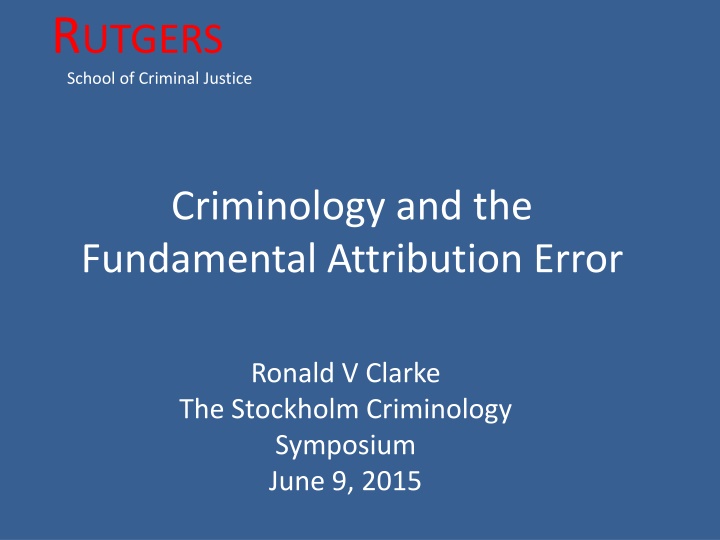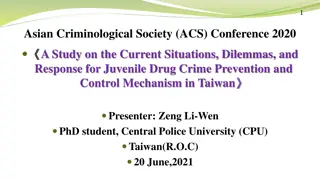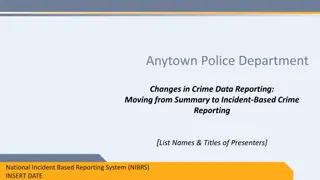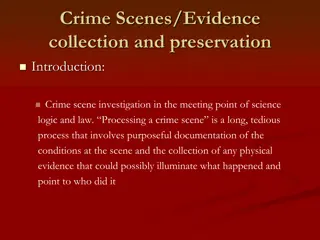Criminology Studies and Crime Prevention: Insights and Findings
This content delves into various studies in criminology, including analysis of absconding rates, social psychology in relation to crime, suicide trends, and crime prevention strategies. From examining absconding rates in training schools to evaluating crime prevention measures like graffiti cleaning and street closures, this content provides valuable insights and findings from the realm of criminology.
Download Presentation

Please find below an Image/Link to download the presentation.
The content on the website is provided AS IS for your information and personal use only. It may not be sold, licensed, or shared on other websites without obtaining consent from the author.If you encounter any issues during the download, it is possible that the publisher has removed the file from their server.
You are allowed to download the files provided on this website for personal or commercial use, subject to the condition that they are used lawfully. All files are the property of their respective owners.
The content on the website is provided AS IS for your information and personal use only. It may not be sold, licensed, or shared on other websites without obtaining consent from the author.
E N D
Presentation Transcript
RUTGERS School of Criminal Justice Criminology and the Fundamental Attribution Error Ronald V Clarke The Stockholm Criminology Symposium June 9, 2015
2 Absconding Rates of Training Schools For Senior Boys South-West England (1964 and 1966) Absconding Rates Absconding Rates School School 1964 1966 1964 1966 1 10 % 10 % 10 26 % 37 % 2 13 % 38 % 11 27 % 25 % 3 14 % 14 % 12 28 % 47 % 4 21 % 18 % 13 29 % 45 % 5 21 % 23 % 14 32 % 43 % 6 22 % 14 % 15 34 % 26 % 7 22 % 21 % 16 46 % 27 % 8 24 % 29 % 17 75 % 50 % 9 25 % 33 %
3 Kurt Lewin (1936) Social psychology: Behavior is a function of both personality and the situation B = f(P.S) Environmental criminology: Crime results from the interaction between a motivated offender and a criminal opportunity Lewin, K. (1936). A Dynamic Theory of Personality. New York: McGraw-Hill..
4 Suicides in England and Wales Clarke and Mayhew, 1988 Year All Methods By Domestic Gas % By Gas 1958 5,298 2,637 49.8 1960 5,112 2,499 48.9 1962 5,588 2,469 44.2 1964 5,566 2,088 37.5 1966 4,994 1,593 31.9 1968 4,584 988 21.6 1970 3,940 511 13.0 1972 3,770 197 5.2 1974 3,899 50 1.3 1976 3,816 14 0.4
5 200+ evaluatedSCP case studies (See www.popcenter.org) Cash reduction in US convenience stores, in Australian betting shops and for bank tellers worldwide Graffiti cleaning on the New York subway to remove the rewards of graffiti Street closures to reduce prostitution, burglary, drug dealing and drive by shootings Anti-robbery screens in London post-offices in the 1980s City guards on public transport in Holland Video cameras in sheltered housing to protect seniors from fraudsters Exact fare systems coupled with drop safe on buses to reduce robbery of U.S. bus drivers in 1970s Responsible drinking practices to control drink-related crime in Queensland resorts Improved street lighting in council housing estates in the UK Fitting alley gates behind terraced housing in Liverpool to deter burglars
6 Review of displacement in 102 situational prevention studies 1. No displacement found in 68 of the studies 2. When found, displacement was never complete 3. Diffusion of benefits found in 39 of the studies Guerette & Bowers (2009) Assessing the Extent of Crime Displacement and Diffusion of Benefits: A Review of Situational Crime Prevention Evaluations. Criminology 47(4): 1331-1368
7 CCTV and Parking Lot Thefts at Surrey University (Poyner 1997) security gate 1 CCTV 4 2 3 University Buildings Parking lots
8 Sutherland s admonition to study criminality, not crime The problem in criminology is to explain the criminality of behavior, not the behavior, as such (page 4) The situation operates in many ways, of which perhaps the least important is the provision of an opportunity for a criminal act (page 5). Sutherland, E. (1947). Principles of Criminology (3rd edition)
9 The Fundamental Attribution Error Following Kurt Lewin, Nisbett and Ross (1980) and other social psychologists described thefundamental attribution error in a series of experiments conducted in the 1970s. The fundamental attribution error is the pervasive human habit of overstating the role of the person and underestimating the role of the situation in explaining people s behavior. Pease and Laycock (2012) have described a pernicious wrinkle of the error: we do not apply it to our own behavior! They explain: We are happy to acknowledge situational determinants of our own peccadilloes. I am bad tempered because I slept badly. He is bad tempered because he is that sort of person.
10 How society inadvertently creates crime 1. WE MANUFACTURE CRIME-PRONE GOODS (cars, credit cards and cell phones with weak security) WE PRACTICE POOR MANAGEMENT (sloppy checkout systems in shops, honor fare systems on public transport, failure to undertake criminal background checks for sensitive employees, etc.) WE PERMIT POOR LAYOUT AND DESIGN OF PLACES (monolithic public housing in the poorest parts of cities, beautiful open plan schools that cannot be defended against determined intruders, etc.) WE NEGLECT SECURITY OF THE ELECTRONIC SYSTEMS THAT REGULATE OUR EVERYDAY LIVES (banking systems that promote money laundering, insurance systems that permit fraudulent claims, welfare systems that allow cheating) WE PASS LAWS WITH UNINTENDED CRIME EFFECTS (drug laws that promote drug trafficking, new subsidies and allowances that produce corruption and fraud, etc.) 2. 3. 4. 5.
11 Avalanche of Increased Security 1. Public housing: 1000s of high rise blocks demolished worldwide and replaced by defensible space designs 2. Private housing: burglar alarms and security design standards 3. Public transport: help points; CCTV, more guards, better CPTED designs 4. Shops: EAS, ink tags, CCTV, bar coding and RFID 5. Convenience stores: cash reduction, two clerks 6. Banks: Large scale heists eliminated by security guards, reduced cash in tills, time release safes and bullet proof screens. 7. Offices: controlled access; ID tags 8. Pubs and clubs: bouncers, responsible drinking practices
12 Even More Security Cars: steering locks in 1970s, immobilizers and central locking in 1990s Credit cards: Improved delivery of cards, POS verification, smart chips Computers: anti-virus programs; spam filters Bank notes: anti-counterfeiting features Public phones: card-operated, strengthened cash boxes. Motoring offenses: Speed/red light cameras and breath tests Street offences: city guards, neighborhood watch, improved lighting Security guards: Now outnumber police in many countries CCTV: Campuses, parking lots, schools, hospitals, city centers and shopping malls, banks and ATMs























